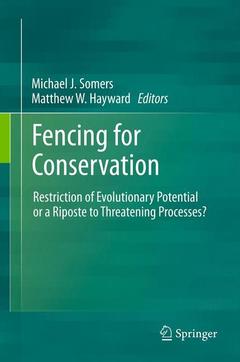Description
Fencing for Conservation, 2012
Restriction of Evolutionary Potential or a Riposte to Threatening Processes?
Language: English
Subject for Fencing for Conservation:
320 p. · 15.5x23.5 cm · Paperback
320 p. · 15.5x23.5 cm · Hardback
Description
/li>Contents
/li>Comment
/li>
Chapter 1.An introduction to fencing for conservation. Matt W. Hayward and Michael J. Somers.- Chapter 2. Perspectives on fencing for conservation based on four case studies: marsupial conservation in Australian forests; bushmeat hunting in South Africa; large predator reintroduction in South Africa; and large mammal conservation in Poland. Matt W. Hayward.- Chapter 3. The relative merits of predator-exclusion fencing and repeated fox baiting for protection of native fauna: five case studies from Western Australia. Paul J. de Tores and Nicky Marlow.- Chapter 4.Fences or ferals? Benefits and costs of conservation fencing in Australia. Chris R. Dickman.- Chapter 5. The use and potential of pest-proof fencing for ecosystem restoration and fauna conservation in New Zealand. Bruce Burns, John Innes and Tim Day.- Chapter 6. Fencing for purpose: A case study of elephants in South Africa. Rob Slotow.- Chapter 7. An adaptive monitoring programme for studying impacts along the western boundary fence of Kruger National Park, South Africa. Ken Ferguson, Laura Adam and Ferran Jori.- Chapter 8. Does the vastness of the Serengeti limit human-wildlife conflicts? Marion L. East, Julius W. Nyahongo, Katja V. Goller and Heribert Hofer.- Chapter 9. Barriers, the beef industry and unnatural selection: a review of the impacts of veterinary fencing on mammals in southern Africa. Michelle E. Gadd.- Chapter 10 Modelling the effect of fences on the viability of spatially structured populations of African wild dogs. Michael J. Somers, Markus Gusset and Fredrik Dalerum.- Chapter 11. Towards a true ecology: exploring the implications for conservation of the human and social dimensions of fencing in the subtropical thicket biome, South Africa. Andrew T. Knight and Richard M. Cowling.- Chapter 12. Ecological, social and financial issues related to fencing as a conservation tool in Africa. Peter A. Lindsey, Chap L. Masterson, Andrew L. Beck and Stephanie Romañach.- Chapter 13. Do fences or humans inhibit the movements of large mammals in Białowieża Primeval Forest? R. Kowalczyk, K. Schmidt and W Jędrzejewski.- Chapter 14. Exploring the value of wolves (Canis lupus) in landscape-scale fenced reserves for ecological restoration in the Scottish Highlands. Christopher Sandom, Joseph Bull, Susan Canney and David W. Macdonald.- Chapter 15. The influence of land use and fences on habitat effectiveness, movements and distribution of pronghorn in grasslands of North America C. Cormack Gates Paul Jones, Michael Suitor, Andrew Jakes, Mark S. Boyce and Kyran Kunkel- Chapter 16. Use of electric fencing and associated measures as deterrents to jaguar predation on cattle in the pantanal of Brazil. Sandra M.C. Cavalcanti, Peter G. Crawshaw Jr. and Fernando R. Tortato.

